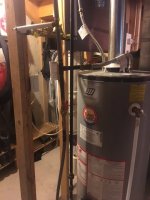Basement_Lurker
One who lurks
I have an odd question which I hope someone will have the knowledge and experience to answer:
I am installing a bottom feed water heater, so the cold inlet is at the bottom of the tank instead of the top. The part I am scratching my head over is the placement of the vacuum relief valve.
For a normal top entry tank, if negative flow occurs in the system, the cold water line flowing into the tank will drain up to the point where the vacuum relief valve is installed. The vacuum relief valve will then do its job and allow air into the system to equalize pressure since it is installed at a point higher than the tank. Because of this, the water in the tank will stay in the tank, and the tank will not suffer any negative pressures.
However, in a bottom feed tank, if negative flow occurs in the system, I feel that the cold water line flowing into the tank would drain, but that the weight of the water in the tank would force the water to flow backwards out of the bottom of the tank until the tank was empty, thereby not allowing the vacuum relief valve to function no matter where it was installed on the cold inlet line. So if I am correct, where should the vacuum relief valve be installed? Should it be on the hot outlet coming out of the top of the tank so as to allow air into the tank if there was ever a reversal of flow?
I spent 15 mins on the phone with the technical support for the manufacturer, and they had ever encountered this question before, and by the end of the discussion I basically felt they didn't know.
Can anyone offer any insights?
thx
I am installing a bottom feed water heater, so the cold inlet is at the bottom of the tank instead of the top. The part I am scratching my head over is the placement of the vacuum relief valve.
For a normal top entry tank, if negative flow occurs in the system, the cold water line flowing into the tank will drain up to the point where the vacuum relief valve is installed. The vacuum relief valve will then do its job and allow air into the system to equalize pressure since it is installed at a point higher than the tank. Because of this, the water in the tank will stay in the tank, and the tank will not suffer any negative pressures.
However, in a bottom feed tank, if negative flow occurs in the system, I feel that the cold water line flowing into the tank would drain, but that the weight of the water in the tank would force the water to flow backwards out of the bottom of the tank until the tank was empty, thereby not allowing the vacuum relief valve to function no matter where it was installed on the cold inlet line. So if I am correct, where should the vacuum relief valve be installed? Should it be on the hot outlet coming out of the top of the tank so as to allow air into the tank if there was ever a reversal of flow?
I spent 15 mins on the phone with the technical support for the manufacturer, and they had ever encountered this question before, and by the end of the discussion I basically felt they didn't know.
Can anyone offer any insights?
thx


